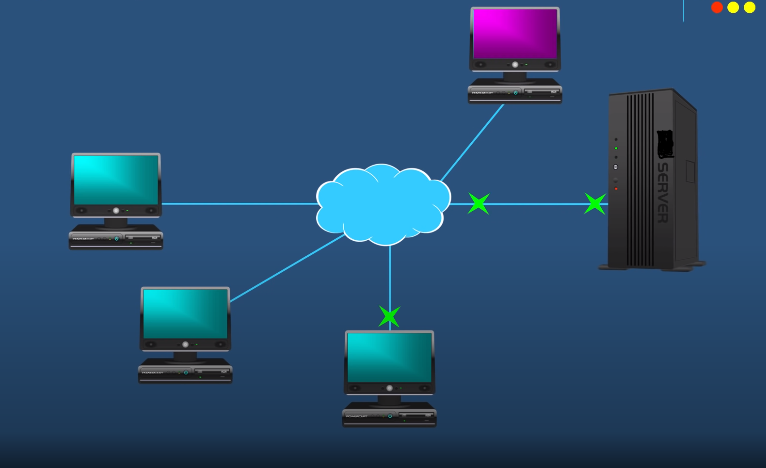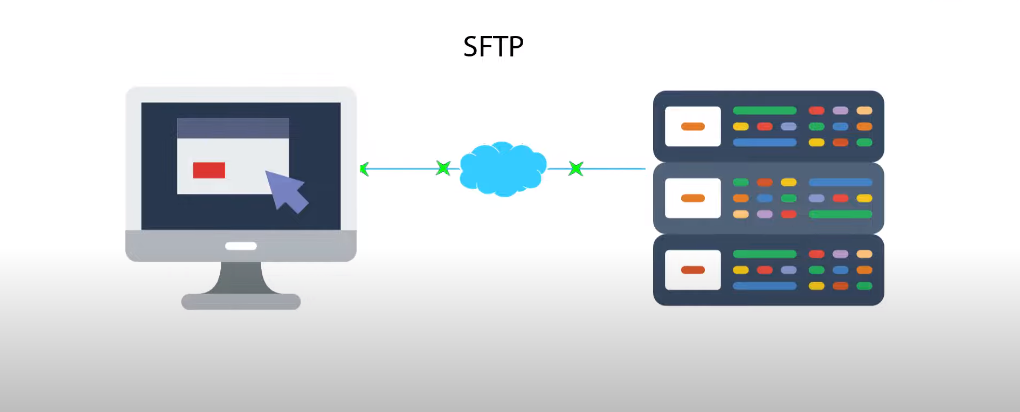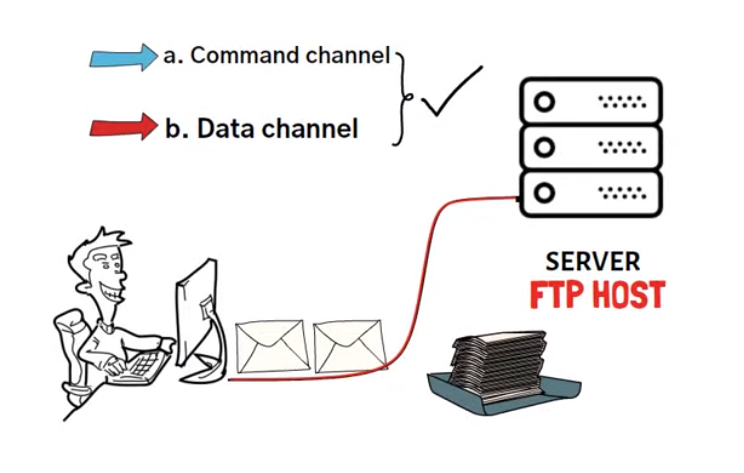SFTP and Its Role in Secure Data Transfer

SFTP (Secure File Transfer Protocol) is a secure method of transferring files over a network. It is a protocol that encrypts data during transmission, making it less susceptible to interception or tampering. SFTP uses Secure Shell (SSH) as its underlying protocol, which provides strong authentication and encryption mechanisms.SFTP is commonly used for transferring large files between servers or for securely transferring files between a client and a server.
Understanding SFTP
SFTP (Secure File Transfer Protocol) is a secure method of transferring files over a network. It is a protocol that encrypts data during transmission, making it less susceptible to interception or tampering. SFTP uses Secure Shell (SSH) as its underlying protocol, which provides strong authentication and encryption mechanisms.SFTP is commonly used for transferring large files between servers or for securely transferring files between a client and a server.
Highlighting its Advantages Over Traditional FTP
Compared to traditional FTP, SFTP offers several advantages. Firstly, SFTP uses encryption to protect data during transmission, which makes it more secure than FTP. Secondly, SFTP uses SSH for authentication, which provides stronger security than FTP’s username and password authentication. Thirdly, SFTP supports larger file sizes and can resume interrupted transfers, making it more reliable for transferring large files.
Need for Data Security
SFTP is a reliable and secure way to transfer data over the Internet. It offers several advantages over traditional FTP, including encryption for data protection, SSH authentication for stronger security, and support for larger file sizes and interrupted transfers. These features make SFTP an ideal choice for businesses and individuals who need to transfer sensitive data securely.
Encryption: The Cornerstone of Data Protection
SFTP is an excellent choice for secure data transfer because it uses encryption to protect data. Encryption is the process of converting plain text into a coded message that can only be read by authorized parties who possess the decryption key. SFTP uses encryption to protect data while it is in transit, making it difficult for unauthorized parties to intercept and read the data. This ensures that sensitive information, such as financial data, personal information, and confidential business data, remains secure during transfer.
Encryption And Its Role in Securing Sensitive Information
Encryption is a security measure that involves converting plain text into a coded message that can only be read by authorized parties who possess the decryption key. It is an essential tool for protecting sensitive information during transfer, as it makes it difficult for unauthorized parties to intercept and read the data. In the context of SFTP (Secure File Transfer Protocol), encryption plays a crucial role in ensuring that data remains secure while it is in transit.
SFTP Encryption: A Layered Approach

SFTP encryption is implemented using a layered approach that involves several levels of security.
The first layer of security is provided by the SFTP protocol itself, which encrypts all data in transit using a combination of symmetric and asymmetric encryption algorithms.
The second layer of security is provided by the SSH (Secure Shell) protocol, which is used to establish a secure connection between the client and server. SSH uses public key cryptography to authenticate the server and client and to establish a shared secret key that is used to encrypt all data in transit.
The third layer of security is provided by the encryption algorithms themselves. SFTP supports several encryption algorithms, including AES (Advanced Encryption Standard), Blowfish, and Twofish. These algorithms are used to encrypt the data using the shared secret key established by SSH.
Finally, SFTP also supports integrity checks, which are used to detect any tampering with the data during transit. Integrity checks use message authentication codes (MACs) to verify the integrity of the data and ensure that it has not been altered in transit.
Overall, the layered approach used by SFTP encryption provides a high level of security for data in transit, making it an essential tool for organizations that need to transfer sensitive information securely.
Best Practices for Data Encryption in SFTP
Here are some best practices for data encryption in SFTP:
1. Use strong passwords: Use complex and unique passwords for SFTP accounts to prevent unauthorized access.
2. Implement two-factor authentication: Use two-factor authentication to add an extra layer of security to SFTP accounts.
3. Use encryption algorithms: Use strong encryption algorithms such as AES to protect data during transit.
4. Regularly update software: Keep SFTP software up-to-date to ensure that any security vulnerabilities are addressed.
Guidelines for Implementing Robust Encryption in Sftp Environments
Here are some guidelines for implementing robust encryption in SFTP environments:
1. Use strong encryption algorithms: Use strong encryption algorithms such as AES (Advanced Encryption Standard) to protect data during transit. AES is a widely accepted and secure encryption algorithm that is used by many SFTP clients and servers.
2. Enable encryption for all data transfers: Ensure that all data transfers are encrypted using SFTP. This will help to prevent unauthorized access and protect sensitive data.
Performance Considerations
When implementing robust encryption in SFTP environments, it’s important to consider performance implications. Here are some tips to help optimize performance:
1. Use hardware acceleration: Consider using hardware acceleration for encryption and decryption tasks. This can significantly improve performance and reduce CPU usage.
2. Use compression: Use compression to reduce the size of data being transferred, which can help to improve performance.
Balancing Security and Usability
When designing a system that balances security and usability, it’s important to consider the following:
1. User experience: The system should be designed with the user in mind, making sure that it’s easy to use and understand.
2. Risk assessment: Conduct a thorough risk assessment to identify potential security threats and vulnerabilities.
3. Access control: Implement access control mechanisms to ensure that only authorized users have access to sensitive data.
4. Encryption: Use strong encryption to protect data in transit and at rest.
Trade-Off Between Data Security And User Convenience
When it comes to data security, there is often a trade-off between security measures and user convenience. While strong security measures can make it more difficult for unauthorized users to access sensitive data, they can also make it more difficult for authorized users to access that same data. A good approach is to find a balance between security and convenience. For example, implementing multi-factor authentication can add an extra layer of security without being too cumbersome for users. Similarly, using encryption can protect data without significantly impacting user experience.
Strategies To Strike A Balance Between Encryption And Usability
When it comes to balancing encryption and usability, several strategies can be employed:
1. Use strong encryption algorithms: Strong encryption algorithms can provide high levels of security without significantly impacting user experience. Implementing encryption at the file level can also help to reduce the impact on performance.
2. Implement selective encryption: Not all data needs to be encrypted. By selectively encrypting only sensitive data, you can reduce the impact on user experience while still providing adequate security.
3. Use secure protocols: When transmitting data over the internet, it’s important to use secure protocols such as HTTPS or SSL/TLS. These protocols encrypt data in transit and help to prevent unauthorized access.
4. Implement two-factor authentication: Two-factor authentication adds an extra layer of security by requiring users to provide two forms of identification before accessing sensitive data. This can include a password and a one-time code sent via SMS or email.
Future of Data Encryption in SFTP
Data encryption is becoming increasingly important in the world of SFTP (Secure File Transfer Protocol). As more and more sensitive information is being transferred over the internet, it’s crucial to ensure that this data is protected from unauthorized access. In the future, we can expect to see advancements in SFTP encryption technology, with stronger and more secure algorithms being developed. Additionally, there may be an increased focus on end-to-end encryption, which ensures that data is encrypted at every stage of the transfer process.
Discussing Emerging Encryption Technologies And Trends
In recent years, there has been a growing concern about the security of sensitive information being transferred over the internet. As a result, there has been a significant focus on developing more advanced encryption technologies to protect this data from unauthorized access. One such technology is SFTP encryption, which is a secure way to transfer files over the internet. SFTP uses a combination of encryption algorithms to protect data during transfer, making it more difficult for hackers to intercept and access the information.
Role Of Artificial Intelligence And Quantum Computing
Artificial intelligence and quantum computing are two rapidly evolving technologies that are likely to have a significant impact on the future of encryption. AI algorithms can be used to analyze large amounts of data and identify patterns that may be used to improve encryption methods. Quantum computing, on the other hand, has the potential to break many of the encryption methods currently in use. While AI and quantum computing offer exciting possibilities for the future of encryption, they also pose new challenges.
FAQs (Frequently Asked Questions)

What is SFTP, and how does it differ from FTP?
SFTP stands for Secure File Transfer Protocol, and it differs from FTP (File Transfer Protocol) in that SFTP uses encryption to secure the transfer of files between a client and a server. This means that the data being transferred is protected from interception and unauthorized access. FTP, on the other hand, does not use encryption, which makes it less secure for transferring sensitive data.
Is SFTP encryption necessary if the data is already encrypted?
It depends on the level of security required for the data. If the data is already encrypted with strong encryption, then using SFTP may not be necessary. However, using SFTP can provide an additional layer of security and assurance that the data is being transferred securely. It is always recommended to use the highest level of security possible when transferring sensitive data.
How does encryption impact SFTP performance?
Encryption can have an impact on SFTP performance, as encrypting and decrypting data requires additional processing power and can slow down the transfer speed. However, the impact on performance is typically minimal and can be offset by using optimized encryption algorithms and hardware acceleration. It is important to balance the need for security with the need for efficient data transfer when using SFTP.
Can encryption be implemented retroactively for existing SFTP systems?
Yes, encryption can be implemented retroactively for existing SFTP systems. However, it may require some additional steps such as generating new encryption keys and configuring the SFTP server and client to use them. It is important to ensure that all parties involved in the SFTP transfer are aware of the encryption implementation and have the necessary keys and configurations to access the encrypted data.
Are there any industry-specific encryption requirements?
Yes, there are industry-specific encryption requirements that organizations must adhere to. For example, the healthcare industry has specific regulations under HIPAA that require the encryption of sensitive patient data during transmission and storage. The financial industry also has specific encryption requirements under regulations such as PCI-DSS. Organizations need to understand and comply with these industry-specific requirements to ensure the security and privacy of their data.
How can organizations ensure secure key management for SFTP encryption?
Organizations can ensure secure key management for SFTP encryption by following these best practices:
1. Use a strong encryption algorithm: Organizations should use a strong encryption algorithm such as AES (Advanced Encryption Standard) for SFTP encryption.
2. Generate strong keys: Organizations should generate strong encryption keys that are at least 128 bits in length. The keys should be randomly generated and not based on any predictable patterns.
Conclusion
In conclusion, organizations can ensure secure key management for SFTP encryption by using strong encryption algorithms and generating strong encryption keys. These best practices can help prevent unauthorized access to sensitive data and ensure the confidentiality and integrity of data during transfer over SFTP.
